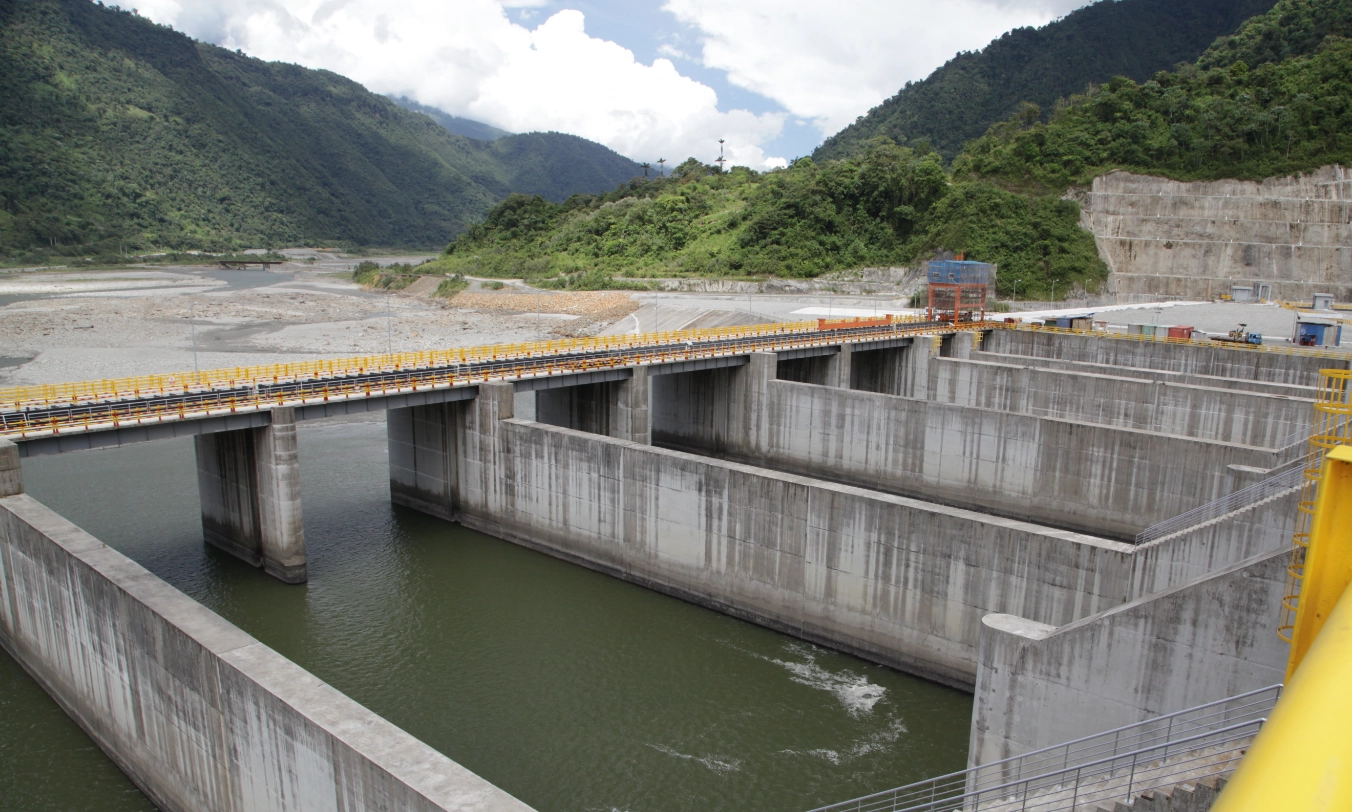The Coca Codo Sinclair Hydroelectric Power Plant located in Ecuador is one of the oldest, largest, and most contentious Chinese projects in Latin America. Destined to provide approximately 20-30% of Ecuador’s daily electricity production, the hydroelectric project was constructed by Chinese state-owned company Sinohydro and financed by a loan from the China Export-Import Bank. Yet following its inauguration in November 2016, scandals have repeatedly catapulted Coca Codo Sinclair into international news: namely, the presence of fissures in the powerhouse’s distributor pipes, threats to the diversion dam from severe regressive erosion, and a multi-million dollar corruption investigation involving ex-President Lenin Moreno.
Furthermore, eight years after its formal inauguration the project has yet to be formally “received” by the Ecuadorian government from the contractor Sinohydro, which would complete the turnkey contract. This is because of the aforementioned powerhouse fissures: despite repeated welding procedures, they have yet to be fully repaired and doubt has been cast on whether a durable fix is possible.
Ecuador and Sinohydro are currently in international arbitration proceedings to determine how the cracks will be resolved. In the meantime, negotiations are reportedly underway between the Ecuadorian government and Sinohydro to conclude a deal in which Ecuador would sign over operation of the project to Sinohydro in exchange for “liquidity”. It is currently operated by the Strategic Public Company Corporación Eléctrica del Ecuador, through a specific Business Unit for the Coca Codo Sinclair complex.
If Sinohydro does assume operations of Coca Codo Sinclair, this may raise alarm bells for critics of Chinese infrastructure projects who warn Global South countries against “debt trap diplomacy.” Although the Chinese “debt trap” narrative has been repeatedly refuted by scholars, the specter remains salient, particularly among U.S. actors. Part of the narrative is that China may seize control of vital infrastructure projects, thereby threatening countries’ sovereignty (Sri Lanka’s Hambantota port is the primary example cited by debt trap proponents).
Nevertheless, the potential leasing of Coca Codo Sinclair to Sinohydro is not the story of a debt trap. Instead, many Ecuadorians would be eager for Sinohydro to assume responsibility for this risky project, which some engineers say is at risk of collapse due to the fissures (in the powerhouse) and, separately, the regressive erosion of the Coca River (at the diversion dam).
Moreover, Sinohydro, and the Chinese government by proxy, is focused on doing reputational damage control rather than seeking a geostrategic foothold in Ecuador. The project’s various scandals have put Chinese media on the defensive and Sinohydro Ecuador even launched a social media campaign to temper harsh criticism. According to multiple sources, Chinese actors are highly attuned to the bad publicity generated by the project as well as the high costs of maintaining the status quo. The deal could potentially solve a dilemma for both Sinohydro and the Ecuadorian state — Sinohydro would not leave behind a much maligned, reportedly «falling apart» project, and Ecuador would gain cash rather than risk further scandals.
Rumors of Ecuador’s possible concession of Coca Codo Sinclair began to circulate in November 2022, when then-Minister of Energy Fernando Santos stated that ideally Sinohydro would “keep” the project. In December 2022, Santos explained that this possibility had been discussed by Sinohydro management, then-President Guillermo Lasso, and the Chinese Ambassador to Ecuador.
Sinohydro would be responsible for the repair, operation, and administration of the hydroelectric facility and, in exchange, would return part of the money Ecuador had invested. He summarized the deal as such: “They run the risk, because it is very high. They say it will last 50 years. Perfect. Give us back our money and we’ll give you the project.” General Manager of Ecuador’s public electricity company CELEC stated that the hypothetical deal with PowerChina, Sinohydro’s parent company, would delegate operation for approximately 30 years.
The possibility of concessioning Ecuador’s largest infrastructure project understandably provoked domestic debate. Critics asserted that this deal would represent a failure for the Ecuadorian state, as it would mean higher electricity prices for citizens. It would effectively privatize public infrastructure which is critical to national development. The government would have to negotiate the price of the concession, its length (likely 20-30 years), and the price per Kilowatt/hour at which the state would buy back electricity from Coca Codo Sinclair. Whether or not concessioning the project would help or hurt Ecuadorian interests hinges on these prices.
Meanwhile, in March 2023 Sinohydro decided to postpone negotiations on Coca Codo Sinclair in light of the Attorney General’s Office indictment of 25 individuals on bribery allegations surrounding the project — including four Sinohydro representatives and a former Chinese Ambassador. The Minister of Energy Fernando Santos repeatedly affirmed that negotiations would move forward, but they proceeded slowly, especially as ex-President Lasso dissolved the National Assembly and called snap elections (mutual death).
Following national elections in August 2023, a meeting was held between the Ministry of Energy and PowerChina, but after new President Daniel Noboa assumed office in November he soon replaced Santos with current Minister of Energy Andrea Arrobo. It was unclear whether Noboa’s administration would proceed with the Coca Codo Sinclair negotiations. Most recently in February 2024, the Ecuadorian Foreign Minister Gabriela Sommerfield relayed in an interview that concessioning Coca Codo Sinclair, together with the Toachi-Pilaton dam, was still on the table. She stated that Chinese entities would operate the dams in exchange for “liquidity,” though she offered no further details.
Coca Codo Sinclair supplied a whopping 40% of Ecuador’s electricity production on March 11 according to the Operador Nacional de Electricidad CENACE. The impact of this project on Ecuadorian’s electricity reliability and cost can hardly be overstated, especially in a context where electricity scarcity is already a critical issue that will likely become more so as a result of climate change. Ultimately, the terms of the deal negotiated between Sinohydro and the Ecuadorian state (the price of the concession, its length, and the electricity price) are paramount.
The real debate is about whether the Ecuadorian public will benefit from leasing a public project to an international company — not the Chinese state’s geopolitical aims. Suppose an agreement can be reached that satisfies both parties as well as the Ecuadorian public. In that case, observers should focus their analysis on the terms of the deal and resist the temptation to fit Coca Codo’s fate into an ill-conceived debt trap narrative.
*This text was originally published on the REDCAEM website.
Autor
PhD candidate in International Relations, with a focus on Chinese infrastructure projects in Latin America at American University. Member of REDCAEM (China-Latin America).












